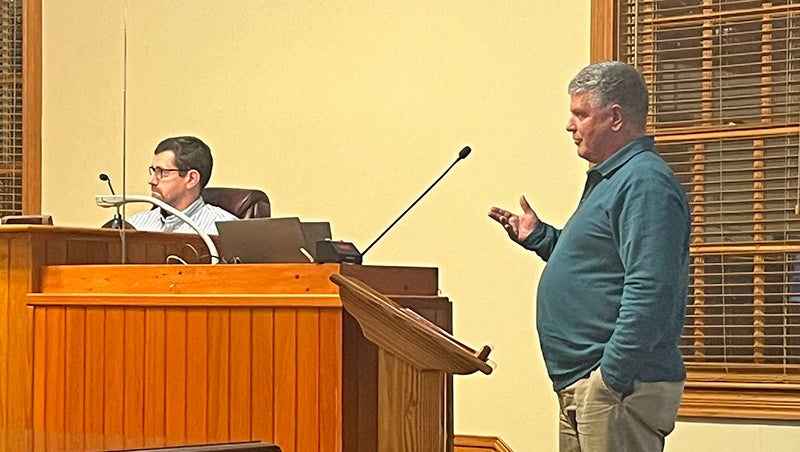Minimum lot size regulations raise red flags for local engineers
Published 4:20 pm Wednesday, February 28, 2024

- Dale Ludwig expressed concerns regarding ADU regulation in terms of short-term rentals at Kitty Hawk’s planning board meeting. Danielle Puleo photo
|
Getting your Trinity Audio player ready...
|
Dale Ludwig, a Kitty Hawk property owner, was the first to approach the town’s planning board on Thursday, February 15 during public comment. His concerns applied to unfinished business regarding proposed accessory dwelling unit (ADU) regulation, which had just been removed from the evening’s agenda. The applicant of this proposed amendment, Amy Wells, a neighbor of Ludwig’s, had been working with town planner Rob Testerman to add language to the town’s ordinance which would regulate ADUs which are being used as short-term rentals in the VR-1 district.
Ludwig shared with the board that he has been running a successful Airbnb out of his property on Herbert Perry Rd. and has had no issues or complaints. The decision to put his property on Airbnb came after a neighbor suggested it. Ludwig claimed several neighbors have Airbnbs, including Wells. He was concerned about future short-term rental regulation: “Just because some people don’t own the property, they think they should be able to take what other people have. They shouldn’t dictate what I should do with my property.”
The board did not discuss this proposed text amendment as it was removed from the agenda in the beginning of the meeting, but will more than likely be addressed at their March meeting.
A good majority of the night’s talk centered around a definition proposal which would require all uplands area used to fulfill minimum lot size requirements be contiguous. Last year, a text amendment was adopted which excluded any type of wetland from being included in minimum lot size calculations. Staff was made aware, after a subdivision proposal came before the boards, that the majority consensus of council was that the minimum lot size (15,000 sq. ft.) was intended to be contiguous. This was not included in the language at the time of adoption. Therefore, staff proposed adding such language to the ordinance in an effort to clarify the perceived original intent.
Two engineers approached the planning board during public comment to offer points in contest to the proposal. Joe Anlauf worried that adding such language would counteractively impact wetlands in a negative way, as engineers have the option to obtain nationwide permitting and stitch wetlands together if they needed to be contiguous. Ralph Calfee felt that regulating such a “nuance” to the ordinance would have more to do with suggesting how to develop a subdivision as opposed to defining minimum lot size. “Folks are going to have to generate a lot of configurations that satisfy that, even if it’s lousy subdivision development layouts.” If the intent is to restrict subdivisions in certain areas that have wetlands, Calfee felt it would be best to express that as the goal of such an ordinance.
“We’ve heard some valid points from the engineers at public comment,” Testerman said as the board began their deliberations. “There are consequences of rushing to do something without looking at all angles of it.” Chair John Richeson tried to see both side of the coin in admitting contiguous language could pose issues while noting that development sometimes involves filling and degrading. Town attorney Casey Varnell then chimed in with posing a situation where uplands are separated by a pocket of wetlands. “You can go get a fill permit and thereby destroy wetlands simply to make them combined.” He noted that this proposed ordinance change could have the potential to force that action, which seemed to be contrary to the original intent of wetland preservation and protection.
“To start making us connect them and do it I think is worse for the environment than just leaving it alone,” board member Jim Geraghty said. “I don’t understand why it has to be contiguous, connecting uplands means filling wetlands to do it. Why would we force people to fill a pocket that may not need to be filled? There’s no reason for it.”
Alternate voting member Craig Merrill posed to Testerman and Varnell whether an entity such as the Army Corps of Engineers would approve a fill permit to follow the letter of the law despite the intent of preservation. “They’re going to go off whether it meets their regulations,” Varnell answered. Fill permits could be obtained for development, such as in the case of a subdivision prior to subdivision approval from the council. To the public commenters’ points, adopting the new language could force developers to make this call prior to the board ever seeing plans.
Geraghty moved to deny the proposed text amendment, but that motion failed in a vote 3-2. The proposal will make its way to the town’s March council meeting.
SUBSCRIBE TO THE COASTLAND TIMES TODAY!





